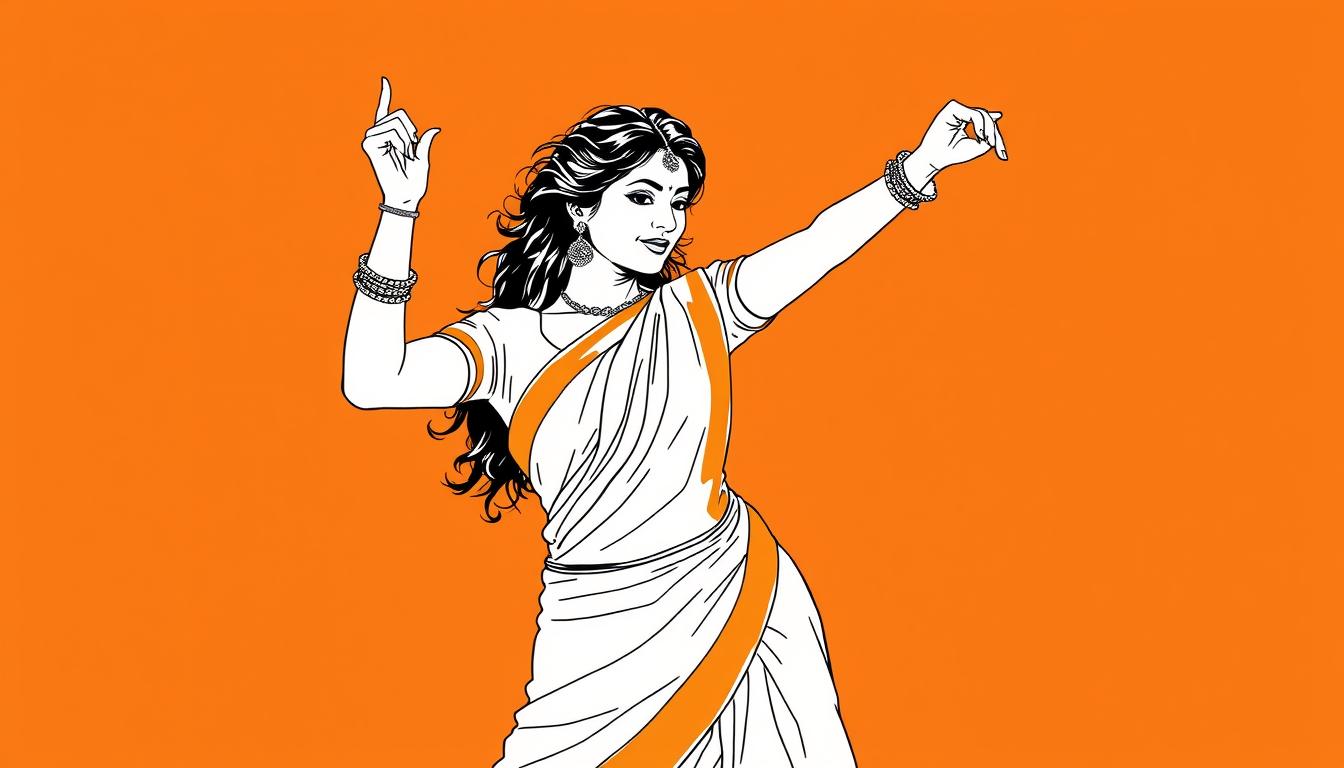Born in Mumbai on May 15, 1967, this actress emerged when Hindi cinema was embracing more dynamic storytelling. She appeared in over 70 films and earned the Padma Shri, India’s fourth-highest civilian honor. Her six Filmfare Awards from seventeen nominations speak to her lasting impact.
The trained Kathak dancer became a national phenomenon. She combined technical precision with emotional depth that captivated critics and audiences alike. Her screen presence redefined what was possible for performers in the industry.
Four decades of work reveal a journey through struggle, meteoric rise, voluntary retreat, and strategic comeback. The “Dhak Dhak Girl” nickname from her electrifying performance in Beta became shorthand for charisma that couldn’t be replicated.
Beyond box office numbers and awards, Madhuri Dixit built a legacy rooted in discipline and respect for her art form. She evolved without abandoning the qualities that made her singular. Her career stands as a masterclass in enduring relevance.
Introduction to a Bollywood Icon
Her name became a byword for a specific kind of screen magic, one that combined technical dance precision with deep emotional resonance. Madhuri Dixit carved a path that moved beyond typical stardom into lasting cultural currency.
Overview of a Legendary Career
Her work in the 1990s set new benchmarks. She balanced mainstream appeal with performances that earned deep respect from industry veterans.
This actress influenced fashion, dance, and audience expectations. She created a template for a leading lady: skilled, emotionally available, and commercially strong.
Critics consistently noted her ability to elevate material. She turned formulaic scenes into memorable moments through perfect timing and expression.
| Area | Impact | Example |
|---|---|---|
| Fashion | Set trends with iconic costumes in films. | Style choices copied nationwide. |
| Dance Vocabulary | Fused classical Kathak with popular choreography. | Dance steps became part of public celebration. |
| Performance Standard | Raised the bar for emotional depth in commercial cinema. | Scenes remembered for nuance, not just plot. |
Global Appeal and Cultural Impact
Her influence crossed oceans. Audiences from New Jersey to Dubai discovered her through films in local theaters.
Dance sequences became viral moments decades before the internet, shared on VHS tapes. Her impact shaped how future generations of actresses approach their craft and careers.
She represents a bridge between classical Indian arts and modern entertainment. Her career brought discipline to mass consumption without dilution.
Early Life and Dance Training
Her journey to stardom began not on a film set, but in the quiet practice rooms where classical dance fundamentals became second nature. The discipline that would define her career took root long before cameras started rolling.
Family Background and Childhood
Growing up in a Mumbai middle-class home, Madhuri Dixit’s family valued both education and cultural arts. Her parents Shankar and Snehlata Dixit created an environment where artistic passion received genuine encouragement.
She balanced schoolwork with intensive dance training from an early age. This dual focus on academics and arts shaped her approach to life and career.
The Dixit household included two elder sisters and a brother. Their support proved crucial when she later made career-changing decisions.
Mastering Kathak and Early Inspirations
At just three years old, she began Kathak training that would span eight formative years. This intensive period built the technical foundation for her future screen presence.
Her talent earned recognition early. A scholarship at age nine validated her dedication publicly.
That early newspaper mention after a Guru Purnima festival performance hinted at what was to come. The journalist noted how “this little girl stole the show” with her commitment.
She briefly studied microbiology before choosing films full-time. Those six months of college demonstrated her intellectual curiosity while dance remained her true calling.
The Kathak training gave her advantages most actresses lacked: technical precision, stamina, and emotional expression through movement. These skills would later translate directly to her cinematic success.
Breakthrough with Tezaab and Early Success
Commercial disappointment marked her initial years in cinema, but persistence would soon meet its perfect opportunity. The journey from obscurity to recognition required navigating a landscape of missed chances and valuable lessons.
Debut Films and Initial Challenges
Her 1984 debut film introduced a promising newcomer, though commercial results fell short. Positive reviews couldn’t overcome the film’s box office performance.
Subsequent releases throughout the mid-1980s continued this pattern. Each project offered screen time to refine her craft despite public indifference.
These lean years built resilience that would later define her career approach. She learned camera techniques and emotional connection away from spotlight pressures.
The Impact of Tezaab on Bollywood
The 1988 release of Tezaab changed everything. Director N. Chandra’s vision paired with her preparation created cinematic magic.
Playing Mohini, a dancer forced into performance, she channeled years of training into the iconic “Ek Do Teen” sequence. The song became a national phenomenon.
Opposite established star Anil Kapoor, she held her ground with compelling intensity. Their chemistry fueled the film’s massive box office success.
Tezaab became the highest-grossing film of 1988. This commercial triumph earned Madhuri Dixit her first Filmfare Award Best Actress nomination, signaling critical recognition had arrived.
| Phase | Key Films | Commercial Result | Critical Reception |
|---|---|---|---|
| Early Career (1984-1987) | Abodh, Awara Baap, Swati | Box office disappointments | Mixed reviews, promising talent noted |
| Breakthrough (1988) | Tezaab | Highest-grossing film of the year | Filmfare Award Best Actress nomination |
| Impact | Established star pairing with Anil Kapoor | Validated perseverance | Technical skill and emotional depth recognized |
Rise to Stardom in the 90s
Film distributors began calculating risk differently when Madhuri Dixit’s name appeared above the title. Her presence signaled guaranteed returns in an industry where female stars rarely carried such weight alone.
Blockbuster Collaborations with Top Actors
The late 1980s launched a remarkable partnership with Anil Kapoor. Their chemistry in Ram Lakhan created the second highest-grossing film of 1989.
She demonstrated impressive range opposite Sunny Deol in Tridev. The film finished as the year’s third biggest hit.
Her 1990 performance in Dil earned the actress her first Filmfare Award. Working with Aamir Khan, she balanced comedy and emotional depth perfectly.
Saajan in 1991 showcased her ability to navigate complex relationships. She held her own against both Sanjay Dutt and Salman Khan.
Signature Dance Sequences and Performances
Her dance numbers became cinematic events. Audiences waited for moments when pure performance took over the narrative.
Each movement articulated emotions that dialogue couldn’t reach. Her technical precision transformed routine songs into unforgettable experiences.
| Film | Year | Box Office Ranking | Key Co-Star |
|---|---|---|---|
| Ram Lakhan | 1989 | 2nd Highest | Anil Kapoor |
| Tridev | 1989 | 3rd Highest | Sunny Deol |
| Dil | 1990 | Highest Grosser | Aamir Khan |
| Saajan | 1991 | Major Hit | Sanjay Dutt/Salman Khan |
Madhuri Dixit in Iconic Romantic Dramas
Two films in particular crystallized her status as the definitive romantic lead of her generation. These projects showcased her range from serious social drama to celebratory family entertainment.
Memorable Roles in Dil and Hum Aapke Hain Koun..!
Her 1992 film Beta presented a character fighting patriarchal manipulation with intelligence and grace. The role earned the actress her second Filmfare Award for Best Actress.
Hum Aapke Hain Koun..! in 1994 became a cultural landmark. Families watched it repeatedly, and wedding planners copied its aesthetic.
Playing Nisha opposite Salman Khan, she balanced tradition with modern desire. Her performance felt both authentic and aspirational.
Defining the “Dhak Dhak Girl” Persona
The nickname emerged from her playful song sequence in Beta. “Dhak Dhak Karne Laga” became shorthand for attraction and charisma.
This persona captured her unique appeal: sensuality without vulgarity. She walked a line few performers managed consistently.
| Aspect | Beta (1992) | Hum Aapke Hain Koun..! (1994) |
|---|---|---|
| Character Type | Educated woman challenging tradition | Modern woman honoring family values |
| Box Office Impact | Biggest hit of the year | Record-breaking worldwide success |
| Award Recognition | Second Filmfare Best Actress award | Third Filmfare Award, first Screen Award |
| Cultural Legacy | Introduced “Dhak Dhak Girl” persona | Guinness World Record holder |
The Guinness Book recognition placed Madhuri Dixit in historical context. Her work achieved both commercial dominance and lasting cultural impact.
Versatility in Action and Dramatic Roles
While dance numbers and romantic leads built her fame, Madhuri Dixit deliberately chose projects that challenged audience expectations. Her dramatic work proved she possessed range beyond commercial cinema.
Critically Acclaimed Performances in Thriller and Drama
The 1989 film Parinda showcased her against type as Paro, a schoolteacher. This role required vulnerability rather than her usual charisma.
Her performance in this serious drama earned critical praise. The film became India’s official Oscar submission.
In Anjaam (1994), she portrayed a revenge-seeking mother. She grounded the violent narrative in authentic maternal rage.
Exploration of Complex Characters
Mrityudand (1997) became a career turning point. She played Ketki Singh, a village woman fighting oppression.
The role demanded stripping away glamor for raw emotion. Critics called it her best performance.
She matched intensity with established dramatic heavyweight Shabana Azmi. This demonstrated her serious acting credentials.
| Film | Character Type | Critical Recognition |
|---|---|---|
| Parinda (1989) | Vulnerable schoolteacher | Oscar submission, serious cinema validation |
| Anjaam (1994) | Revenge-driven mother | Praise for emotional grounding |
| Mrityudand (1997) | Oppressed village woman | Career-best performance acclaim |
These roles showed strategic career management. She used commercial success to fund artistic risks that aged well beyond typical star vehicles.
Television Appearances and Dance Reality Shows
Judging dance competitions allowed her to transition from performer to mentor, shaping the next generation of talent. Her television work demonstrated strategic career evolution rather than retreat from cinema.
Judging on Jhalak Dikhhla Jaa and Dance Deewane
Madhuri Dixit brought her Kathak background to reality television. She served as a judge on Jhalak Dikhhla Jaa for several years starting in 2010.
Her presence elevated the show beyond entertainment. Contestants knew they faced someone with real technical expertise.
Dance Deewane extended her television influence across multiple seasons. Her feedback balanced encouragement with honest assessment.
Transitioning from Films to Small Screen
The move to television came from strategic positioning. Reality shows offered sustained visibility traditional films couldn’t match.
These years on television maintained her public presence. Film roles for actresses her age had become limited.
Her 2022 Netflix series The Fame Game marked her streaming debut. She played an actress whose public image masked private turmoil.
| Show | Role | Years Active | Platform |
|---|---|---|---|
| Kahin Na Kahin Koi Hai | Host | 2002 | Sony TV |
| Jhalak Dikhhla Jaa | Judge | 2010-2014, 2022 | Colors TV |
| Dance Deewane | Judge | 2018-present | Colors TV |
| The Fame Game | Lead Actress | 2022 | Netflix |
Philanthropic Contributions and Public Advocacy
Beyond the cinematic spotlight, a quieter dedication to social causes has defined a significant part of her legacy. Madhuri Dixit channels her influence into advocacy that demands more than a photo opportunity.
Her work builds on decades of public trust. She approaches these issues with the same seriousness she brought to her craft.
Engagement with UNICEF
Since 2014, Madhuri Dixit has partnered with UNICEF. Her focus remains on protecting child rights and preventing labor and trafficking.
This multi-year commitment demonstrates a deep understanding of the issues. She prepares thoroughly, ensuring her voice adds substance, not just celebrity.
Her fluency in Marathi and Hindi helps her connect directly with communities. This breaks down barriers that often limit effective communication.
Beti Bachao Beti Padhao Campaign Impact
In 2015, the government appointed her as an ambassador for the Beti Bachao Beti Padhao campaign. The initiative aims to improve welfare services for girls across India.
Her family-friendly image gives her unique credibility with parents and grandparents. She leverages this trust to challenge deep-seated social preferences.
Her own experience raising a family informs this work. She understands both the privilege and vulnerability that come with visibility.
Awards, Honors, and Box Office Milestones
Her trophy shelf tells a story of sustained excellence. Six Filmfare Awards stand as milestones in a career defined by both popular appeal and critical respect.
These honors reflect a journey measured in consistent quality. They mark moments where her work resonated deeply with audiences and industry peers alike.
Filmfare Awards and National Recognitions
Madhuri Dixit earned a record seventeen nominations for the prestigious Filmfare Award. She converted six of those into wins, a testament to her standout performances.
She secured the Filmfare Award for Best Actress four times. Victories for Dil, Beta, Hum Aapke Hain Koun..!, and Dil To Pagal Hai highlighted her peak years.
Her versatility was further acknowledged with a Best Supporting Actress win for Devdas in 2002. This award recognized her ability to elevate a complex character.
Beyond film awards, the Government of India honored her with the Padma Shri in 2008. This civilian award placed her contributions in a national context.
A 2011 Filmfare Special Award celebrated her completing twenty-five years in the industry. It honored the rare longevity and enduring impact of her career.
Record-Breaking Box Office Achievements
Commercial success often accompanied critical acclaim. Her films frequently dominated the box office, breaking records and setting new benchmarks.
The 1994 family drama Hum Aapke Hain Koun..! became a cinematic phenomenon. It grossed approximately ₹1.35 billion worldwide.
This film held the record for India’s highest-grossing film for seven consecutive years. Its success demonstrated her unparalleled power to draw audiences into theaters.
These box office milestones cemented her status as a bankable star. They proved her appeal could generate massive commercial returns across different decades.
Evolving Career and Notable Comeback Films
Choosing family over fame, this actress stepped away from the spotlight at her peak. Her career path took a deliberate turn, leading to a series of strategic returns that redefined her legacy.
Hiatus and Return with Aaja Nachle
After marrying Dr. Shriram Nene in 1999, Madhuri Dixit moved to Denver. This decision marked a significant hiatus from the film industry.
Her comeback film, Aaja Nachle, released in 2007. The movie centered on dance, her greatest strength. Although the film did not succeed commercially, her performance was widely praised.
This role earned the actress a Filmfare Award nomination for Best Actress. It proved her talent remained undiminished.
Recent Ventures Including Bhool Bhulaiyaa 3 and Total Dhamaal
She returned to the screen in 2014 with Dedh Ishqiya. Her role as Begum Para earned critical acclaim for its complexity.
In 2019, she appeared in the comedy Total Dhamaal. This film reunited her with Anil Kapoor after nearly two decades.
Her role in the 2024 release Bhool Bhulaiyaa 3 contributed to the film’s massive box office success. This project stands among the highest-grossing Indian movies of all time.
These recent movies show a savvy selection of projects. She chooses roles that leverage her iconic status while adapting to new industry landscapes.
Media Influence and Cultural Resonance
The transition from performer to cultural touchstone happens when an artist’s work transcends the screen and enters public consciousness. This actress achieved that rare status through moments that became shared cultural property.
Iconic Fashion and Dance Moments
Her purple sari from Hum Aapke Hain Koun..! sparked nationwide fashion trends. Wedding planners and designers copied the aesthetic that made traditional wear feel contemporary.
Dance sequences like “Ek Do Teen” revolutionized how musical numbers functioned in Hindi cinema. They proved a well-executed performance could drive a film’s success independently. Her movements created a visual language that crossed regional boundaries.
Magazine covers from Debonair to Filmfare documented her evolution. Each image captured changing relationships between female stardom and the industry.
Impact on Pop Culture and Future Generations
Young actresses consistently reference her work in interviews. Choreographers cite her as inspiration, and reality show contestants choose her songs to prove their skill.
Her presence on Forbes India’s Celebrity 100 list since 2012 quantifies influence beyond box office numbers. It measures brand value and cultural capital with economic impact.
Media coverage shifted from reviewing films to analyzing her life choices. This treatment demonstrates lasting relevance that pure nostalgia cannot support.
Reflecting on a Stellar Journey in Cinema
Her filmography charts the evolution of Hindi cinema itself, a four-decade journey through changing technologies and audience tastes. From her 1984 debut to recent hits, the actress navigated every shift with sharp instinct.
Collaborations defined her path. Working with Sanjay Dutt brought a unique dynamic of intensity and grace. Films like Hum Aapke Hain Koun..! with Salman Khan became cultural landmarks.
Later choices showed remarkable range. In Gulaab Gang, she led a vigilante group. Her Dedh Ishqiya performance as Begum Para was a masterclass in mature complexity.
Madhuri Dixit’s career is a lesson in resilience. It’s built on smart choices, not just constant success. Her journey reflects the changing possibilities for women in film.
This legacy is not just about awards or box office records. It’s about a sustained, intelligent performance across an entire industry’s transformation. A truly stellar journey.




